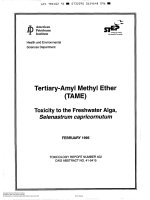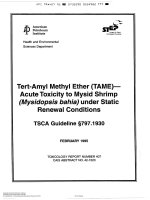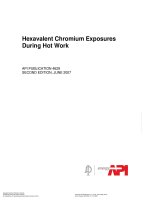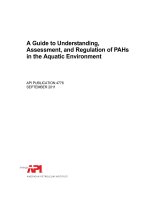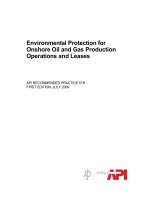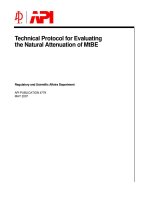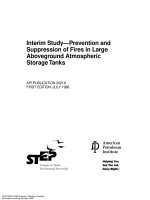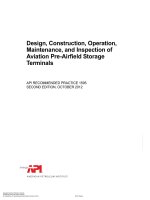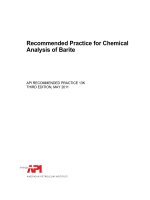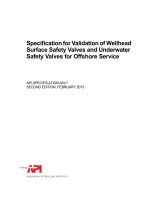Api publ 4774 2008 (american petroleum institute)
Bạn đang xem bản rút gọn của tài liệu. Xem và tải ngay bản đầy đủ của tài liệu tại đây (1.15 MB, 142 trang )
The Environmental Behavior of
Ethylene Dibromide and
1,2-Dichloroethane in Surface
Water, Soil, and Groundwater
API PUBLICATION 4774
DECEMBER 2008
The Environmental Behavior of
Ethylene Dibromide and
1,2-Dichloroethane in Surface
Water, Soil, and Groundwater
Regulatory and Scientific Affairs Department
API PUBLICATION 4774
DECEMBER 2008
PREPARED UNDER CONTRACT BY:
DALLAS ARONSON
PHILIP HOWARD, PH.D.
SYRACUSE RESEARCH CORPORATION
Special Notes
API publications necessarily address problems of a general nature. With respect to particular circumstances, local,
state, and federal laws and regulations should be reviewed.
Neither API nor any of API's employees, subcontractors, consultants, committees, or other assignees make any
warranty or representation, either express or implied, with respect to the accuracy, completeness, or usefulness of
the information contained herein, or assume any liability or responsibility for any use, or the results of such use, of any
information or process disclosed in this publication. Neither API nor any of API's employees, subcontractors,
consultants, or other assignees represent that use of this publication would not infringe upon privately owned rights.
API publications may be used by anyone desiring to do so. Every effort has been made by the Institute to assure the
accuracy and reliability of the data contained in them; however, the Institute makes no representation, warranty, or
guarantee in connection with this publication and hereby expressly disclaims any liability or responsibility for loss or
damage resulting from its use or for the violation of any authorities having jurisdiction with which this publication may
conflict.
API publications are published to facilitate the broad availability of proven, sound engineering and operating
practices. These publications are not intended to obviate the need for applying sound engineering judgment
regarding when and where these publications should be utilized. The formulation and publication of API publications
is not intended in any way to inhibit anyone from using any other practices.
Any manufacturer marking equipment or materials in conformance with the marking requirements of an API standard
is solely responsible for complying with all the applicable requirements of that standard. API does not represent,
warrant, or guarantee that such products do in fact conform to the applicable API standard.
All rights reserved. No part of this work may be reproduced, translated, stored in a retrieval system, or transmitted by any means,
electronic, mechanical, photocopying, recording, or otherwise, without prior written permission from the publisher. Contact the
Publisher, API Publishing Services, 1220 L Street, N.W., Washington, D.C. 20005.
Copyright © 2008 American Petroleum Institute
Foreword
Nothing contained in any API publication is to be construed as granting any right, by implication or otherwise, for the
manufacture, sale, or use of any method, apparatus, or product covered by letters patent. Neither should anything
contained in the publication be construed as insuring anyone against liability for infringement of letters patent.
Suggested revisions are invited and should be submitted to the Director of Regulatory Analysis and Scientific Affairs,
API, 1220 L Street, NW, Washington, D.C. 20005.
Executive Summary
This report reviews the available environmental fate literature for two compounds, ethylene dibromide
(EDB) and 1,2,-dichloroethane (1,2-DCA). The purpose of this report is to serve as a reference for
environmental professionals evaluating potential risks at former leaded gasoline fueling sites where EDB
or 1,2-DCA is detected in groundwater.
EDB was previously used as a soil fumigant and as a leaded gasoline additive while 1,2-DCA is currently
produced in large quantities as a commercial chemical. 1,2-DCA was also used as a leaded gasoline
additive. EDB and 1,2-DCA were added to the lead mix in order to prevent the build-up of solid lead
oxides on spark plugs and exhaust values in piston engines. The sale of leaded fuel for use in on-road
vehicles was banned in 1996, although fuel containing lead can still be used for off-road uses including in
aircraft, racing cars, farm equipment, and marine engines.
The current presence of 1,2-DCA in air, surface water, and groundwater samples can be attributed mainly
to its high production volume. EDB is not typically found in recent air or surface water samples since its
use as a soil fumigant is no longer permitted and because of limited use of leaded fuels. However, EDB
and 1,2-DCA have been reported in groundwater and soil samples at some sites where leaded gasoline
was previously dispensed.
The physical/chemical similarities of the two compounds indicate that they will behave similarly in the
environment. Both compounds are volatile, have relatively high water solubilities, and are soluble in
organic solvents. Transport data show that they readily volatilize from water and soil surfaces as pure
compounds and have low Koc values. This indicates that they have the potential to leach through soil to
groundwater, although studies also indicate that a residual amount remains trapped in soil by absorption
or in residual NAPL. Hydrolysis half-lives are slow, on the order of 1 to 10 years for EDB and tenfold
longer for 1,2-DCA.
Biotic degradation is reported for both compounds under aerobic and anaerobic conditions in laboratory
studies. Based on these data, 1,2-DCA appears to be more resistant to biodegradation than EDB.
Evidence for the anaerobic biodegradation of 1,2-DCA in the field includes the presence of
biodegradation products in groundwater and changes in 13C/12C ratios of 1,2-DCA as the groundwater
moves downgradient from the source area. More limited field data exist for EDB. The field study data
collected for 1,2-DCA and EDB are typically reported as disappearance rate constants, particularly for
aquifer studies. The use of these values as biodegradation half-lives is not appropriate, as loss due to
other processes (both transport and abiotic degradation processes) is included in this rate constant.
Fuel hydrocarbons present at leaded fuel release sites may also slow the biodegradation of 1,2-DCA
and/or EDB in the environment. Laboratory studies for both EDB and 1,2-DCA were nearly always run
using a single compound. Reported biodegradation rates are slower for these compounds in the presence
of fuel-contaminated groundwater.
ii
Table of Contents
Executive Summary ...................................................................................................................................... ii
List of Tables ................................................................................................................................................ v
List of Figures .............................................................................................................................................. vi
I. Introduction .............................................................................................................................................. 1
II. Technical Approach ................................................................................................................................ 2
III. Ethylene Dibromide (EDB) ................................................................................................................... 2
A. Historical and Current Use Patterns .................................................................................................... 2
B. Physical Properties .............................................................................................................................. 4
C. Transport Processes ............................................................................................................................. 6
1. Transport from Water Surfaces ........................................................................................................ 6
2. Transport in Soil .............................................................................................................................. 7
D. Transformations ................................................................................................................................ 12
1. Abiotic Transformations ................................................................................................................ 12
a. Hydrolysis .................................................................................................................................. 12
b. Reaction with Sulfur Nucleophiles ............................................................................................ 15
c. Photolysis ................................................................................................................................... 17
2. Biotic Transformations .................................................................................................................. 17
a. Pure Culture Studies ................................................................................................................... 17
b. Enrichment Culture, Defined Culture, and Sewage Studies ...................................................... 20
c. Microcosm Studies ..................................................................................................................... 21
d. Field Studies............................................................................................................................... 28
1. Soil Fumigant Use.................................................................................................................. 30
2. Leaded Fuel Release Sites...................................................................................................... 31
E. Monitoring Data ................................................................................................................................ 32
1. Release Site Data ........................................................................................................................... 32
2. Non-site Based Environmental Monitoring ................................................................................... 42
F. Fugacity Estimates ............................................................................................................................. 49
IV. 1,2-Dichloroethane (1,2-DCA) ............................................................................................................ 52
A. Historical and Current Use Patterns .................................................................................................. 52
B. Physical Properties ............................................................................................................................ 54
C. Transport Processes ........................................................................................................................... 56
1. Transport from Water Surfaces .................................................................................................. 56
2. Transport in Soil ........................................................................................................................ 57
D. Transformations ................................................................................................................................ 60
1. Abiotic Transformations ................................................................................................................ 60
a. Hydrolysis .................................................................................................................................. 60
b. Reaction with Sulfur Nucleophiles ............................................................................................ 62
c. Photolysis ................................................................................................................................... 62
2. Biotic Transformations .................................................................................................................. 63
a. Pure Culture Studies ................................................................................................................... 63
b. Enrichment Culture, Defined Culture, and Sewage Studies ...................................................... 67
c. Microcosm Studies ..................................................................................................................... 68
d. Field Studies............................................................................................................................... 75
E. Monitoring Data ................................................................................................................................ 86
1. Release Site Data ........................................................................................................................... 86
2. Non-site Based Environmental Monitoring ................................................................................... 92
F. Fugacity Estimates ........................................................................................................................... 101
iii
V. Conclusions/Recommendations for Further Study ............................................................................. 104
A. Properties ........................................................................................................................................ 104
B. Biodegradation ................................................................................................................................ 104
C. Occurrence and Persistence at Field Sites ....................................................................................... 104
VI. References.......................................................................................................................................... 106
iv
List of Tables
Table 1. A comparison of structure and nomenclature for the lead scavengers ethylene dibromide and
1,2-DCA ................................................................................................................................................ 1
Table 2. Physical/chemical properties for EDB ........................................................................................... 6
Table 3. Soil adsorption data for EDB ....................................................................................................... 10
Table 4. Hydrolysis half-lives reported for EDB ....................................................................................... 14
Table 5. Half-lives for the reaction of EDB with sulfur nucleophiles ....................................................... 16
Table 6. Pure culture strains studied for their ability to degrade EDB ...................................................... 19
Table 7. Aerobic biodegradation microcosm studies for EDB .................................................................. 23
Table 8. Anaerobic biodegradation microcosm studies for EDB............................................................... 26
Table 9. Disappearance half-lives for EDB in field studies ....................................................................... 29
Table 10. 1st Order disappearance rate constants for EDB for 65 wells at LUST sites in SC (Falta, 2004a)
............................................................................................................................................................ 31
Table 11. EDB monitoring data for release sites ....................................................................................... 35
Table 12. Surface water concentrations for EDB....................................................................................... 43
Table 13. Groundwater concentrations for EDB........................................................................................ 43
Table 14. Outdoor air concentrations for EDB .......................................................................................... 45
Table 15. Indoor air concentrations for EDB ............................................................................................. 48
Table 16. Fugacity estimates for EDB (7-day half-life in water and soil, 28-day half-life in sediment)... 50
Table 17. Fugacity estimates for EDB (70-day half-life in water and soil, 280-day half-life in sediment)
............................................................................................................................................................ 51
Table 18. Physical/chemical properties for 1,2-DCA ................................................................................ 55
Table 19. Soil adsorption data for 1,2-DCA .............................................................................................. 59
Table 20. Hydrolysis half-lives for 1,2-DCA ............................................................................................ 61
Table 21. Half-lives for the reaction of 1,2-DCA with sulfur nucleophiles............................................... 62
Table 22. Pure culture strains studied for their ability to degrade 1,2-DCA.............................................. 65
Table 23. Aerobic microcosm/column biodegradation studies for 1,2-DCA ............................................ 70
Table 24. Anaerobic microcosm biodegradation studies for 1,2-DCA ...................................................... 73
Table 25. Aquifer field studies for 1,2-DCA ............................................................................................. 79
Table 26. Hydrogeological conditions for 1,2-DCA field studies discussed in text .................................. 83
Table 27. 1,2-DCA monitoring data for release sites................................................................................. 87
Table 28. Surface water concentrations for 1,2-DCA ................................................................................ 93
Table 29. Groundwater concentrations for 1,2-DCA ................................................................................. 94
Table 30. Outdoor air concentrations for 1,2-DCA ................................................................................... 96
Table 31. Indoor air concentrations for 1,2-DCA .................................................................................... 100
Table 32. Fugacity estimates for 1,2-DCA (90-day half-life in water and soil, 360-day half-life in
sediment) ........................................................................................................................................... 102
Table 33. Fugacity estimates for 1,2-DCA (330-day half-life in water and soil, 1320-day half-life in
sediment) ........................................................................................................................................... 103
v
List of Figures
Figure 1. Annual U.S. production of EDB from 1969 to 1983 (U.S. ITC, 1970–1984) .............................. 3
Figure 2. Annual U.S. Production of 1,2-DCA from the years 1952 to 1994 (U.S. ITC, 1953–1995)...... 53
vi
I. Introduction
The following document reviews the available environmental fate literature for two compounds, ethylene
dibromide (EDB) and 1,2-dichloroethane (1,2-DCA). While these particular names suggest that these two
compounds have different structures, EDB and 1,2-DCA are structurally similar (Table 1). Neither
compound contains a double bond despite the common names of ethylene dibromide and ethylene
dichloride. The two structures differ only with the presence of either bromine or chlorine substituents.
Table 1. A comparison of structure and nomenclature for the lead scavengers ethylene
dibromide and 1,2-DCA
Chemical name used in report
Chemical structure
CAS registry number
Molecular formula
SMILES notation
CAS-9CI name
Synonyms
EDB
Br
H
H
1,2-DCA
Br
H
H
106-93-4
C2H4Br2
BrCCBr
Ethane, 1,2-dibromoEthylene dibromide
1,2-Dibromoethane
1,2-Ethylene dibromide
DBE
Cl
H
H
Cl
H
H
107-06-2
C2H4Cl2
ClCCCl
Ethane, 1,2-dichloroEthylene dichloride
1,2-Dichloroethane
1,2-Ethylene dichloride
EDC
EDB was previously used as a soil fumigant and as a leaded gasoline additive while 1,2-DCA is currently
produced in large quantities as a commercial chemical (nearly 8.2 billion kilograms in the mid-1990s)
with most of this, >96%, used as a chemical intermediate. 1,2-DCA was also used as a leaded gasoline
additive. The current presence of 1,2-DCA in air, surface water, and groundwater samples can be
attributed mainly to its high production volume. EDB is not typically found in recent air or surface water
samples since its use as a soil fumigant and leaded gasoline additive are no longer permitted by the U.S.
EPA. However, it has been reported in groundwater and soil samples affected by historical uses.
The following sections provide a review of environmental fate data for both compounds as well as
monitoring data from sites where direct release occurred and from larger monitoring studies where
concentrations cannot be attributed to a single release. Section II briefly describes the literature search
process. Section III contains all available environmental information for EDB while Section IV contains
the available information for 1,2-DCA. Within Sections III and IV, transport processes are considered
initially, followed by abiotic and biotic transformation processes, and then monitoring data. While EDB
and 1,2-DCA are considered separately, the environmental processes relevant for each compound are
expected to be similar. For example, the physical trapping of pure EDB by soil samples was well studied
because of its use as a soil fumigant. Similar studies were not conducted for 1,2-DCA; however, based on
the mechanism reported for EDB and the structural similarity of the two compounds, it is likely to be
important for 1,2-DCA as well. In such cases, the reader is referred back to the relevant section of the
report where the original data are reported.
1
II. Technical Approach
The literature search began with an electronic search of two files in SRCs Environmental Fate Data Base
(EFDB), DATALOG, and BIOLOG, as sources of information on abiotic and biotic transformation
processes, environmental transport, physical/chemical properties, and environmental concentrations. In
particular, DATALOG contains a citation index catalogued by environmental process (e.g., adsorption,
biodegradation, hydrolysis, photooxidation) as well as field and ecosystem studies, physical/chemical
properties (e.g., Henry’s Law constant, vapor pressure, water solubility), and environmental
concentrations in multiple media (e.g., air, water, soil, sediment). Because DATALOG only catalogues
mixed culture studies, BIOLOG was also queried as a source of information on pure culture or
defined/enrichment culture biodegradation studies. Both EDB and 1,2-DCA were well-represented in the
available literature. A Chemical Abstracts search was also conducted using a combination of degradation
and media keywords for citations published during and after year 2000.
In addition to the in-house literature searches and the references cited in the Request for Proposal (RFP),
SRC searched the reference section of every identified paper for additional relevant articles. This was
particularly effective in identifying recent papers from less well known sources, such as those from
conference proceedings. Online searches using GOOGLE were used to identify field study data and
recent monitoring data that may not have been published. Recent articles such as those by Falta and
Bulsara (2004), Burton (2005b) and Miner (2005) published online by LUSTLine were also located using
this approach. Relevant presentations from the Annual Clemson University Hydrogeology Symposium,
as well as government sites for ATSDR Health assessments, and Record of Decision documents for
Superfund sites were also located from online sources.
III. Ethylene Dibromide (EDB)
A. Historical and Current Use Patterns
EDB was first produced in 1923 (Scheibe and Lettenmaier, 1989). The major historical uses of EDB
were as a soil fumigant and as an additive to leaded gasoline and aviation fuel. Small amounts of EDB
were used as an intermediate in the synthesis of dyes and pharmaceuticals and as a solvent for resins,
gums, and waxes (Fishbein, 1979; U.S. EPA, 1977). EDB is currently used as a chemical intermediate
particularly for manufacturing vinyl bromide (a flame retardant used in modacrylic fibers), as a
nonflammable solvent for resins, gums, and waxes (U.S. DHHS, 2005), in the treatment of felled logs for
bark beetles and control of wax moths in beehives (ATSDR, 1992), and as a lead scavenger in leaded
fuels for off-road uses such as in aircraft, racing cars and marine engines (Burton, 2005b; U.S. EPA,
1996). Monitoring data indicating the presence of very low concentrations of EDB in ocean water and
ocean air suggest that EDB also may be formed naturally in ocean environments due to growth of macro
algae (Class and Ballschmiter, 1988; Laturnus, 1995).
The total annual U.S. production of EDB peaked in 1974 at 150.9 million kilograms and by 1983,
production was only 70.5 million kilograms (U.S. ITC, 1970–1984) (Figure 1). This decrease can be
attributed to two events: the cancellation of EDBs registration for use as a pesticide in 1983/1984 and
more importantly, the widespread installation of catalytic converters on passenger cars and light trucks for
U.S. distribution in model year 1975 due to tightened emission standards (U.S. EPA, 1996) and the
subsequent phase-out of leaded gasoline beginning in 1978. IUR (Inventory Update Reporting) CUS
production volumes for EDB are available for the following years: 1986, >45.5M to 227M (millions of
kilograms); 1990, >22.7M to 45.5M; 1994, >4.5M to 22.7M, 1998 and 2004 both >0.45M to 4.5M (U.S.
EPA, 2007).
2
Ethylene dibromide production (million kg/yr)
180
160
140
120
100
80
60
40
20
0
1968
1970
1972
1974
1976
1978
1980
1982
1984
Year
Figure 1. Annual U.S. production of EDB from 1969 to 1983 (U.S. ITC, 1970–1984)
EDB was registered as a pesticide, mainly for the control of soil nematodes, in 1948 and was typically
sold as a liquid mixture with petroleum solvents. EDB was also used in spot fumigations of grain milling
machinery and flour mills, post-harvest fumigation of grain, and in the control and prevention of
infestations in fruits and vegetables (Alexeeff et al., 1990). Minor uses included the control of mountain
pine bark beetles, moths in vault-stored furniture and clothing, termites, Japanese beetles, and wax moths
(Alexeeff et al., 1990; U.S. EPA, 1977). The discovery of EDB in stored grain and in well water in 1983
resulted in an EPA ban on agricultural uses (U.S. EPA, 1977). In the 1983 Federal Register notice
cancelling EDBs registration for use as a soil fumigant, it is noted that based on the “geographic range of
contaminated groundwater sites and reports of leaching of EDB through the soil column in the west and
southwest… that EDB will leach wherever it is applied” (U.S. EPA, 1983). In 1984, the registration of
EDB for use as a fumigant on grains and grain milling machinery was cancelled.
In 1975, approximately 3–4% of the total 1975 EDB production was used as a pesticide (U.S. EPA,
1977). By 1983, nearly 10 million kg EDB active ingredient was applied to ~400,000 ha of a variety of
crops in the U.S. (11% of the total EDB production for that year) (Pignatello and Cohen, 1990). In
contrast, in 1983, an estimated 111 million kg/yr EDB was used as a lead scavenger in leaded gasoline
and aviation fuel (Pignatello and Cohen, 1990).
The commercial sale of leaded gasoline began in 1923 (Burton, 2005a). EDB was added to leaded motor
fuel as of 1925 (Burton, 2005a). EDB and 1,2-DCA were added to the lead mix in order to prevent the
build-up of solid lead oxides on spark plugs and exhaust values in the piston engine (Burton, 2005b). The
volatile lead bromide and lead chloride formed during the engine combustion process were then released
to the air. The amount of EDB added to leaded gasoline is dependent on the concentration of lead.
Leaded fuels from 1942 to present day contain 1.0 mole 1,2-DCA and 0.5 mole of EDB per mole of alkyl
3
lead (Falta, 2005; U.S. EPA, 1984). Prior to 1942, varying molar ratios of EDB to 1,2-DCA were used
(Falta, 2005). Aviation fuel which contains only EDB (at 1.0 mole EDB per mole of alkyl lead) has twice
as much EDB as leaded gasoline.
Lead concentrations in gasoline have varied considerably since lead was shown to reduce spark knock in
engines in the early 1920’s. Initially, a maximum limit of 3.17 g lead/gallon was recommended by the
federal government in 1926. This was increased in 1959 to 4.23 g lead/gallon due to increased
compression ratios and octane requirements of engines at this time (Gibbs, 1990). Lead concentrations
actually reached historic average highs of only 3.0 g lead/gallon and 2.5 g lead/gallon for premium and
regular gasolines, respectively, in the late 1960s (Gibbs, 1990). By the 1970s, improvements were made
in refining processes resulting in higher octane base gasoline (Gibbs, 1990) and the U.S. EPA enacted
regulations that systematically limited lead concentrations in the U.S. gasoline pool. These regulations
are covered by Gibbs (1990) in some detail. By 1979, the average lead content for large refiners
(producing >50,000 barrels daily) was set at 0.8 g lead/gallon and 2.65 g lead/gallon for small refiners
(for leaded and unleaded gasoline together). After several further changes, a maximum limit of 0.5 g
lead/gallon was set across all leaded gasoline manufactured by each refinery in 1985. By 1988, an
average of 0.1 g lead/gallon was reached for all U.S. leaded gasoline.
In 1995, leaded fuel made up only 0.6% of total gasoline sales in the U.S. (U.S. EPA, 1996). The sale of
leaded fuel for use in on-road vehicles was banned in 1996, although fuel containing lead can still be used
for off-road uses including in aircraft, racing cars, farm equipment, and marine engines (U.S. EPA, 1996).
For example, EDB is still found in several leaded aviation gasoline products: Avgas 80, Avgas 100, and
Avgas 100LL (low lead) (Burton, 2005b). Avgas 100LL is the most commonly used aviation fuel for
spark-ignition internal combustion engines (e.g., single piston airplanes) (Florida Department of
Environmental Protection, 2006). The typical composition of the TEL-CB tetraethyl lead package
currently produced by Ethyl Corporation for use in leaded fuels (61.49% tetraethyllead, 17.86% EDB,
18.81% 1,2-DCA) is similar to the classic formulation of ethyl fluid. A second package, TEL-B, contains
61.49% tetraethyllead and 35.73% EDB which is similar to the formulation used for Avgas (Burton,
2005b).
B. Physical Properties
Physical/chemical properties for EDB are presented in Table 2. EDB has relatively high vapor pressure
and water solubility values. Based on its vapor pressure, EDB is expected to volatilize in dry soils which
is the basis of its use as a soil fumigant. Its Henry’s Law constant indicates that EDB will volatilize
readily from water surfaces.
EDB is miscible in many organic solvents. If released to the environment in a fuel mixture, it will move
with the light non-aqueous phase liquid (LNAPL) by gravity through the vadose zone potentially to
groundwater. The dissolution of a single compound from a mixture such as gasoline in contact with water
is different than its dissolution as a pure compound. For the release of a pure compound such as EDB,
water-phase concentrations at the NAPL-water interface are at the solubility limit in water. However, for
a compound in a gasoline mixture at the NAPL-water interface, the maximum concentration in the water
phase is estimated as the effective solubility. This can be presented as a retardation coefficient (total
concentration/fraction in mobile-water phase) in a saturated soil matrix.
4
In soil the retardation coefficient, Ri, is:
Ri =
[θ w + ρ s ⋅ f oc ⋅ K oc ,i ]
θw
= 1+
ρ s ⋅ f oc ⋅ K oc,i
θw
Eq. (1)
With an immobile residual oil phase (gasoline) present, based on presumed ideal Raoult’s law partitioning
⎛
θ ⋅ ρ MWi ⎞
θ o ⋅ ρ o MWi
⎜⎜θ w + ρ s ⋅ f oc ⋅ K oc ,i + o o ⋅
⎟⎟
⋅
ρ s ⋅ f oc ⋅ K oc ,i
Si
MWo ⎠
Si
MWo
⎝
= 1+
+
Ri =
θw
θw
θw
Eq. (2)
Equivalently, for a measured gasoline to water partition coefficient
Ri =
(θ
w
+ ρ s ⋅ f oc ⋅ K oc ,i + θ o ⋅ ρ o ⋅ K gw,i )
θw
= 1+
ρ s ⋅ f oc ⋅ K oc ,i θ o ⋅ ρ o ⋅ K gw,i
+
θw
θw
Eq. (3)
With θw (cm3-water/cm3-soil) volumetric moisture fraction in soil matrix, equal to the total soil porosity in
saturated soil; ρs (g-soil/cm3-soil) is the soil dry bulk density; foc (g-oc/g-soil) is the mass fraction of
organic carbon in soil; and Koc,i (cm3-water/g-oc) is the chemical-specific organic carbon-water partition
coefficient. MWi is the molecular weight of the chemical, Si is the pure chemical aqueous solubility limit.
With the chemical of interest as a small fraction of the total residual phase, values of θo (cm3-oil/cm3soil), ρo (g-oil/cm3-oil), and MWo (which is a function of oil mixture composition) will be relatively
constant and the factor Ri will be independent of the total oil mixture concentration in soil.
The gasoline to water partition coefficient can be estimated from the octanol to water partition coefficient
as:
K gw = K ow ⋅
MWoc tan ol
MWo
Eq. 4
EDBs gasoline-water partition coefficient (Table 2) indicates that once in contact with groundwater, it
will dissolve more rapidly out of the LNAPL in the groundwater than will benzene (benzene has a
gasoline:water partition coefficient of 350) (Cline et al., 1991; Falta, 2004b). Based on EDBs
gasoline:water partition coefficient, Pignatello and Cohen (1990) reported that groundwater in contact
with gasoline LNAPL at lead levels present in 1990, will contain approximately 80 μg/L EDB. Falta
(2004b), however, reported a potential maximum concentration of 1900 μg/L for EDB near a residual or
LNAPL gasoline source determined from EDBs gasoline:water partition coefficient. If EDB is released
alone or as a spill of grain bin fumigant (e.g., mixtures of EDB with carbon tetrachloride and/or
1,2-DCA), the EDB would be expected to move through the vadose zone potentially to the groundwater
as a dense non-aqueous phase liquid (DNAPL) based on its density compared to water. Once EDB is
dissolved in groundwater, it is not expected to markedly change the water density; therefore, EDB will
move with the bulk of the groundwater flow (Pignatello and Cohen, 1990).
5
Table 2. Physical/chemical properties for EDB
Property
Ethylene dibromide
CAS Registry Number
Structure
106-93-4
CH2Br
Physical description
Molecular weight
Melting point (°C)
Boiling point (°C)
Solubility
Vapor pressure
Octanol-water partition coefficient
Henry’s Law constant
Gasoline-water partition coefficient
(dimensionless)
Specific gravity (liquid)
Specific gravity (vapor)
Equilibrium aqueous concentration
Diffusion coefficient in dry air
Diffusion coefficient in water
Density
Vapor density relative to air
Heat of vaporization
Percent in saturated air
Conversion factors
Reference
CH2Br
Colorless, heavy non-flammable
liquid
187.86 g/mol
9.97
131.6
Water: 3910 mg/L at 25 °C
Octanol: miscible
Organic solvents: miscible
11.2 mm Hg at 25 °C
91.2
6.5x10-4 atm-m3/mol at 25 °C
0.029 (dimensionless)
152
2.179 at 25 °C
6.5 at 25 °C
1900 μg/L
0.0813 cm2/sec (20 °C)
0.0708 cm2/sec (0 °C)
1.0x10-5 cm2/sec (25 °C, estimated)
2.701 at 25 °C
6.1; density of EDB saturated air is
1.08 (air = 1)
+53 cal/gm at 25 °C
At saturation, the concentration of
EDB is 1.3% by volume at 25 °C
1 ppm = 7.68 mg/m3 in air
1 mg/m3 = 0.13 ppm in air
1 mg/L = 130 ppm at 25 °C/760 mm
Hg
U.S. EPA (1977)
SRC (2007)
SRC (2007)
Horvath et al. (1999)
Johns (1976)
Alexeeff et al. (1990)
Daubert and Danner (1985)
Hansch et al. (1995)
Rathbun (1998)
Falta and Bulsara (2004)
Pignatello and Cohen (1990)
Alexeeff et al. (1990)
Alexeeff et al. (1990)
Henderson (2005)
Pignatello and Cohen (1990)
Pignatello and Cohen (1990)
van Agteren et al. (1998)
U.S. EPA (1977)
U.S. EPA (1977)
U.S. EPA (1977)
U.S. EPA (1977)
C. Transport Processes
1. Transport from Water Surfaces
The release of EDB to water results in rapid volatilization. Overall mass transfer coefficients for the
volatilization of EDB from water are dependent on wind speed (Rathbun and Tai, 1987). Both gas-film
and liquid film coefficients are important in determining EDBs resistance to volatilization from water
(Rathbun and Tai, 1986). Lyman et al. (1982) estimated liquid- and gas-phase exchange coefficients of
16 and 1400 cm/hr, respectively, and a mass transfer coefficient of 11.4 cm/hr. Based on these values, a
volatilization half-life of 4 hours can be estimated using a wind speed of 3 m/sec and a water speed of
1 m/sec (Lyman et al., 1982). Rathbun and Tai (1987) measured gas-film coefficients for the
volatilization of EDB from water of 286 and 533 m/d (1192 and 2221 cm/hr, respectively) for low (0.1
m/sec) and high (2.0 m/sec) windspeeds, respectively, at 25 °C (Rathbun and Tai, 1987). Hsieh et al.
(1993) measured mass-transfer coefficients of EDB at varying impeller speeds (150 to 500 rpm). Mass
transfer coefficients of 0.14, 0.53, 1.05, and 1.30 hr-1 were reported for 150, 200, 400, and 500 rpm,
6
respectively. Gas film constants of 0.68 and 0.410 are reported by Hsieh et al. (1993) and Rathbun and
Tai (1987), respectively. A water-film reference substance parameter of 0.633 indicates that the waterfilm mass-transfer coefficient for the volatilization of EDB will be 63.3% that of the reaeration coefficient
for the absorption of oxygen by a stream (Rathbun, 1998). An air-film reference-substance parameter of
0.393 indicates that the air-film mass-transfer coefficient for the volatilization of EDB from a stream will
be 39.3% that of the mass transfer coefficient for the evaporation of water (Rathbun, 1998).
Mackay and Yeun (1983) measured volatilization rates of EDB in a 6 m long, 0.61 m deep, and 0.60 m
wide wind-wave tank. Overall mass transfer coefficients of 23.6, 45.3, 54.7, and 77.2 x10-6 m/sec were
measured for windspeeds of 5.96, 8.57, 10.31, and 77.2 m/s, respectively. Based on their results, a water
evaporation half-life of 4.26 hours can be calculated (windspeed of 8.57 m/sec, 0.61 m depth) (Mackay
and Yeun, 1983). The authors state, however, that laboratory-derived mass transfer coefficients are
generally expected to be higher than those that would be measured in the environment at the same
windspeed. An evaporation half-life in water of 6.4 minutes was reported by Chiou et al. (1980) at
23.1°C, an initial concentration of 0.1 ppm, 1.6 cm depth, and stirring speed of 100 rpm. In still air, the
evaporation rate of EDB from water is 1.24x10-5 g/cm2-sec (Chiou et al., 1980). Volatilization data from
spill sites for 1,2-DCA (Section IV, C.1) confirm that volatilization of these small molecules from water
surfaces is rapid.
2. Transport in Soil
The movement of a chemical in the vadose zone is dependent on both transport and adsorption processes.
Based on different release scenarios, EDB in the vadose zone can be found dissolved in solution, as a
vapor, as pure compound adsorbed to soil, as free NAPL, or as residual NAPL. Dissolved EDB will
move with the infiltrating water to the water table via advection while vapor-phase EDB will move by
diffusion through the soil (Pignatello and Cohen, 1990). EDB present in an LNAPL (such as a mixture of
leaded gasoline) or DNAPL (such as a grain fumigant spill) will move mainly downward with the NAPL
through the pores of the soil due to gravitational and capillary forces. If only a small quantity of NAPL is
released, it may be contained in the vadose zone by the soil. However, if the amount of NAPL is
sufficiently large, the bulk of the NAPL can move through the vadose zone to the groundwater table. An
LNAPL will accumulate at the groundwater table, while a DNAPL will continue to migrate downward
until it encounters a sufficient confining stratum. The NAPL’s movement in the soil is determined by
many factors including soil porosity, soil permeability, and capillary pressure. During movement
downwards, NAPL can become “trapped” within the soil matrix due to capillary forces leaving residual
NAPL behind in the soil (Rixey, 1996). This residual saturation may represent a long-term source of
soluble NAPL components to the environment (Garg and Rixey, 1999; Rixey, 1996).
Sorption of vapor-phase EDB to soil has been studied by Thomason and McKenry (1974) and Sawhney
and Gent (1990). In soil chamber studies, EDB was injected into dry soil (montmorillonite silty clay
loam soil, 13:62:25% sand:silt:clay, 1.1% organic matter, 7.7% w/w water) at a depth of 30.5 cm and at
an application rate of 47 L/ha commercial product (Thomason and McKenry, 1974). EDB diffused
radially outwards from the point of injection. A vapor-phase concentration of 4.5x10-7 moles/L (0.05
ppm) at 90 cm depth was reached within 7 days. Loss of EDB to the atmosphere was measured in a
sandy loam soil (68:22:15% sand:silt:clay, 0.6% organic matter). Injection was at a depth of 30.5 cm and
air was passed over the soil surface at 0.80 km/hr. After 14 days, approximately 1% of the total was lost
to the atmosphere. Under field conditions, it was anticipated that this value would be greater (Thomason
and McKenry, 1974). The results from Thomason and McKenry (1974) differ from volatilization halflives of 0.4 and 3.4 days at 1 and 10 cm depths, respectively, estimated by Jury et al. (1984).
The sorptive capacity of vapor-phase EDB to two different soils, the sandy loam and the silty clay loam
described above was measured under different conditions of temperature and soil moisture (Thomason
7
and McKenry, 1974). At moisture tensions >15 bars, the sorptive capacity was greatly increased in both
soils. The sorptive capacity was greater for the sandy loam soil than the silty clay loam and for soil
incubated at 15 °C over soil at 25 °C. A mass balance in soil at 15 °C found approximately 24, 24, 50,
and 2% of the initially-added EDB in the soil water phase, unaccounted for, in the soil particle phase and
in the soil vapor phase, respectively, by day 7 post-treatment. Mass balance measurements on day 15
post-treament found 20, 40, 38, 1, and 1% of the initially-added EDB in the soil water phase, unaccounted
for, in the soil particle phase, in the soil vapor phase, and lost naturally to the atmosphere, respectively
(Thomason and McKenry, 1974). Sawhney and Gent (1990) measured the vapor-phase sorption of EDB
to a series of clay minerals. The rate of EDB sorption was high initially but slowed considerably over the
remaining study period; 3, 5, 6, and 9% EDB by weight was sorbed to columns filled with pyrophyllite,
kaolinite, illite, and smectite, respectively. Sorption was not correlated with BET (Brunauer, Emmett,
Teller) surface areas. EDB desorption from the columns was also initially rapid but again became slower
as the study proceeded.
Results from early studies show linear sorption isotherms for aqueous-phase EDB (Call, 1957; Phillips,
1964). Phillips (1964) reported that EDB sorption to a sand loam (34.2: 45.5: 7.7: 7.4% coarse sand, fine
sand, silt, and clay, respectively, 4.15% organic matter), a silt loam (0.5: 68.7: 10.0: 10.9% coarse sand,
fine sand, silt, and clay, respectively, 3.28% organic matter), and a peaty soil (6.4: 9.5: 7.8: 30.9% coarse
sand, fine sand, silt, and clay, respectively, 30.6% organic matter) was linear for each soil. The moisture
content of soils affects the sorption of EDB with drier soils showing greater adsorption. The transition
point for this observation is reported to be between 5 and 20% water/dry weight soil (Pignatello and
Cohen, 1990).
Recent studies have suggested that the sorption of EDB may also be affected by the presence of other
compounds (Pignatello, 1990a). The sorption of EDB to granular activated carbon was measured as a
single solute and as a mixture with five other compounds (chloroform, chlorodibromomethane,
bromoform, trichloroethene, tetrachloroethene) at varying concentrations (Crittenden et al., 1985). As a
single solute, EDB had a Kp value of 0.4808 over a concentration range of 32 to 1750 μg/L. In the
presence of other compounds, the sorption of EDB decreased significantly over the entire concentration
range due to competitive interactions. The Kp of EDB decreased by a factor of 3.1 (from 0.77 to 0.25)
when sorbed trichloroethene (TCE) concentrations of 0 to 120 mg/kg, respectively, were present
(Pignatello, 1990a). In the presence of o-dichlorobenzene, the Kp of EDB decreased by a factor of 1.4
(from 0.77 to 0.55) at sorbed o-dichlorobenzene concentrations of 0 to 240 mg/kg, respectively
(Pignatello, 1990a). Using a peat (BET surface area of 1.4 m2/g, organic-carbon content of 49.3%) and a
mineral soil (BET surface area of 11.2 m2/g, organic-carbon content of 1.26%), Chiou and Kile (1998)
measured the sorption of EDB in both single-solute and binary-solute systems. In single-solute systems,
EDB showed non-linearity at low relative concentrations of EDB in water but the sorption isotherm
became linear at medium to high relative concentrations of EDB for both soils. The apparent non-linear
capacity of EDB on the peat and mineral soils is 0.18 mg/g and <0.008 mg/g, respectively, with apparent
saturation when the ratio of solute concentration to solute solubility is approximately 0.010 to 0.015
(Chiou and Kile, 1998). This non-linearity was attributed to the presence of “high surface area
carbonaceous material” (HSACM) which becomes saturated at higher relative concentrations of EDB
(Chiou and Kile, 1998; Chiou et al., 2000). In preparations of a humic acid fraction free of HSACM and
a fraction enriched in HSACM, the non-linear behavior of EDB was enhanced in the enriched fraction
over the HSACM free fraction (Chiou et al., 2000). Log Koc values for the linear portions of the EDB
isotherms are 1.28 and 1.23 for the peat and mineral soils, respectively. The presence of TCE (at 370
mg/L), 3,5-dichlorophenol (at 1400 mg/L), or phenol (at 5900 mg/L) suppresses the non-linearity reported
for EDB on both soils (Chiou and Kile, 1998).
8
Soil-water partition coefficients (Koc values) for EDB in the solution phase range from 12 to 160
(Table 3) but average about 50 to 65. The available Koc values indicate that EDB is not significantly
adsorbed to soil. Based on EDBs Koc values and its relatively high water solubility, EDB can and, based
on available monitoring data, does leach through the vadose zone to groundwater. Aquifer environments
typically have low concentrations of organic carbon. After 24 hours, there was no detectable sorption of
EDB to unconsolidated aquifer fines (0.1% organic carbon) with a limit of determination of 0.1 L/kg
(Pignatello et al., 1990). With a Kp of 0.1 L/kg, a retardation factor of 2 can be estimated (Pignatello and
Cohen, 1990). This value has not been independently verified for EDB in the field however.
Groundwater retardation factors of 1.17 and 2.65 were estimated for an aquifer with an foc of 0.001 and an
foc of 0.01, respectively (Falta et al., 2005a).
9
1.49, 2.08,
1.70
0.153
2
foc = fraction of organic carbon
CEC = cation exchange capacity, mequiv/100 g
1
1.31
1.49
0.856
0.303
0.011
0.0161
0.0165
0.026
0.018
0.0149
0.0066
<0.1
Aquifer fines (<100
um diameter)
Soil
Silt loam
Silt loam
Silt loam
Sandy loam
0.0012–0.0013
5.0
Peaty loam
0.00290–0.126
0.021
0.0493
0.00126
0.008
0.25–0.45
2.0
0.57
Silt loam
foc1
Peat soil
Mineral soil
2 soils
Soil
Pond sediment
Soil
Several soils
Sandy loam
Kp
(L/kg)
Soil type
Table 3. Soil adsorption data for EDB
135
129
103
50
83
57.4
45.9
<83
33
44
36–160
12–21
19.1
17.0
39.7, 40.0
69
71
Koc (L/kg)
Soil characteristics
1% sand, 31% clay, CEC2 = 17, pH 5.6
15% sand, 34% clay, CEC2 = 29, pH 7.8
pH of 4.97
pH of 4.43
Assumption that organic matter is 50%
organic carbon
Assumption that organic matter is 50%
organic carbon
26% clay, 3.3% sand, 69% silt, pH 6.8; Koc
assumption that organic matter is 50%
organic carbon
BET surface area of 1.4 m2/g
BET surface area of 11.2 m2/g
Reference
Rogers and McFarlane (1981)
Rogers and McFarlane (1981)
Walton et al. (1992)
Walton et al. (1992)
Steinberg et al. (1987)
Pignatello et al. (1990)
Phillips (1964)
Chiou and Kile, 1998
Chiou and Kile, 1998
Cohen et al. (1984)
Hassett et al. (1983)
Jafvert and Wolfe (1987)
Kenaga and Goring (1980)
Mingelgrin and Gerstl (1983)
Phillips (1964)
Chiou et al. (1979)
10
The adsorption studies above measure the partitioning of EDB between the solid and solution phases in
soil or sediment. In these studies, sorption to soil is based on weak chemical bonds (van der Waals) that
are formed and broken between the soil and EDB (Pignatello, 1990c). The Koc/Kp values reported in
Table 3 and the sorption isotherm experiments typically use study protocols where equilibrium is
assumed to have been reached within 24 hours. While EDB added to soil is expected to adsorb/desorb in
a rapidly reversible process based on this premise, it has been shown that a portion of the added EDB
behaves in a “non-equilibrium” manner during the desorption phase. This has been attributed to the
physical “trapping” of EDB within the soil matrix. This process is considered separately from the
“trapping” of residual NAPL as discussed earlier in this section.
Similar to other small, low molecular weight halocarbons, EDB can become physically trapped within the
soil matrix possibly due to tortuosity or constriction in pore structure and that release is determined by
diffusion processes characterized by very slow kinetics and a large temperature dependence (Pignatello,
1990a, 1990b; Steinberg et al., 1987). Pulverization of EDB-residual soil results in the complete release
of the trapped EDB (Steinberg et al., 1987). Studies specifically investigating the entrapment of EDB in
soil are provided below.
Kp values from three soils (soil 1, 1.11% organic carbon; soil 2, 1.61% organic carbon; soil 3, 1.65%
organic carbon) fumigated up to 20 years previously (170, 230, 300 mL/g) were two orders of magnitude
greater than Kp values determined from 24-hour equilibration periods (1.49, 1.70, 2.08 mL/g) (Steinberg
et al., 1987). This indicates that the desorption of residual, trapped EDB is extremely slow with an
estimated 50% equilibrium reached in 23–31 years at 25 °C, assuming a diffusion rate law (in a 1:2 soilwater suspension with mild agitation) (Pignatello et al., 1987).
EDB was added to Cheshire soil at a concentration of 100 μM (18.8 mg/kg) in aqueous solution
(Pignatello, 1990c). After a sorption period of 1.8 and 7 days and a desorption phase using adsorbent
beads in the soil suspension, 0.564 and 0.921 mg/kg (3 and 4.9 μM), respectively, remained as a slowdesorbing residual fraction (quantified using a hot solvent extraction procedure) (Pignatello, 1990c). The
structural characteristics of the soil matrix involved in this non-equilibrium sorption were further studied
(Pignatello, 1990c). Overall, the amount of EDB residual was reported to be greater with increasing
concentrations of organic carbon, although not linearly (Pignatello, 1990c). The EDB residual
concentration for each particle size fraction of an Agawam soil (36:8% silt:clay, 2.57% organic carbon)
was measured. The majority of residual EDB was found in the silt and coarse sand fractions following a
7-day sorption phase (34.2, 19.1, 41.5, and 5.3% of residual in the medium to very coarse sand, very fine
to fine sand, silt, and clay fractions, respectively) (Pignatello, 1990c). On an organic carbon basis, 9.94,
59.0, 23.8, and 3.49 mg/kg EDB was found in the medium to very coarse sand, very fine to fine sand, silt,
and clay fractions, respectively (Pignatello, 1990c). From these results, the authors attributed nonequlibrium desorption of EDB to the slow diffusion of EDB from “remote sites in the soil organic matter
matrix”. The distribution of EDB between different soil size fractions in two different soils was reported
by Steinberg et al. (1987). EDB concentrations of 69, 142, 111, and 21 μg/kg were reported for diameter
ranges of 106–250, 53–106, 2–53, and 0–2 μm, respectively, for one soil. EDB concentrations of 104,
164, 66, and 34 μg/kg were reported for the second soil, respectively. Concentrations were highest for the
very fine sand fraction (53–106 μm) and lowest in the clay fraction (<2 μm) (Steinberg et al., 1987).
Steinberg et al. (1987) cited “extremely tortuous or sterically hindered diffusion paths through
microporous structures” as the reason for diffusion-limited desorption of EDB.
The entrapment of EDB, reported in soil, has been shown to occur in aquifer sediments as well
(Pignatello and Cohen, 1990). A residual of 18 μg/kg reported in aquifer sediment following incubation
for 4 days with a solution of 10 mg/L EDB was attributed to the trapping of EDB in the soil/aquifer
material pore structure (Pignatello et al., 1990). In addition, Pignatello et al. (1990) reported higher EDB
11
concentrations in soil cores from a contaminated aquifer than would have been predicted based on Kp and
EDB concentrations in the water.
This trapped residual may represent a potential low-level, slow-release source to these environments
(Pignatello and Cohen, 1990) or a mechanism for plume retardation over decades or longer. Mayer et al.
(1991) studied the effects of temperature and precipitation on EDB groundwater concentrations from an
11-meter deep domestic well located in Whatcom county, Washington, an area that historically used EDB
as a soil fumigant. The initial concentration of EDB was 1.69 μg/L although the concentration varied
over the next 27 months from a low of 0.94 to a high of 2.29 μg/L. Concentrations were negatively
correlated with precipitation. The authors suggest that the infiltration of water from precipitation initially
dilutes the EDB in the aquifer followed by slow EDB infiltration from overlying soils working to
reestablish the EDB concentrations prior to the precipitation event (1 to 3 months were required to
reestablish EDB levels).
D. Transformations
1. Abiotic Transformations
a. Hydrolysis
EDB is slowly hydrolyzed with published half-lives ranging from approximately 1 to 15 years (Table 4).
The attack of EDB by H2O can occur at the carbon atom giving the substitution product 2-bromoethanol
and then further to ethylene glycol via ethylene oxide or at the α-hydrogen leading to the elimination
product vinyl bromide (Pignatello and Cohen, 1990).
1. SN2 (substitution) hydrolysis reaction of EDB in water:
H
H
H
H
H
H
H
H
Br B r
O
H O CH2
CH2O H
Br OH
2-B rom oethanol
EDB
Ethylene glycol
E thylene oxide
2. E2 (elimination) reaction of EDB in water:
H
H
H
H
H
H
Br Br
EDB
H
Br
V in y l b r o m id e
The hydrolysis of EDB is primarily SN2 with conversion to ethylene glycol based on results from several
studies (Table 4). Vogel and Reinhard (1986) are the only authors reporting vinyl bromide as a major
reaction product during nucleophilic attack. Their data suggest that the elimination reaction and not SN2
substitution may be the most important reaction mechanism in some cases. This study was criticized by
others because the product identification method may not have been able to identify ethylene glycol, and
buffer effects were not addressed (Pignatello and Cohen, 1990). In addition, it was suggested that the
EDB concentration used by Vogel and Reinhard (1986), 100 ppm, was not typical of groundwater
contamination by EDB. Moye and Weintraub (1988) suggest that at lower concentrations, as might be
found in groundwater (10–100 μg/L), ethylene glycol and bromide ions account for nearly complete
degradation of EDB. However, as the rates of both elimination and substitution processes are first order
12
with respect to organic reactant, the product distribution is not expected to change with different initial
concentrations of EDB. Given an initial concentration of 100 μg/L EDB, 30 μg/L ethylene glycol is
expected via hydrolysis and 6 μg/L vinyl bromide via elimination (Reinhard and Vogel, 1988). The
elimination reaction is reportedly 9 to 12 times slower than the substitution reaction (Barbash and
Reinhard, 1989; Reinhard and Vogel, 1988). Pseudo first-order rate constants for EDB for SN2 and E2
reactions between EDB and H2O at 25 °C are 3.7x10-4 day-1 and 3.1x10-5 day-1, respectively (Barbash and
Reinhard, 1989).
The hydrolysis of EDB is independent of pH in the environmental pH range of 5 to 9 (Jeffers and Wolfe,
1996; Roberts et al., 1993). Jeffers and Wolfe (1996) studied the neutral and alkaline hydrolysis of EDB
in distilled water. The hydrolysis of EDB is dominated by neutral hydrolysis. The reaction at pH 9 is
responsible for only 10% of the total observed hydrolysis (Kb of 2.5x10-10 M-1min-1).
Haag and Mill (1988) studied the effect of aquifer materials on the hydrolysis rate of several haloalkanes
(isopropyl bromide, 1,1,1-trichloroethane, 1,1,2,2-tetrachloroethane). The sediment was collected from
Lula, Oklahoma at a depth of 5.4 to 6.4 meters and had a total organic carbon content of 0.02%, a total
surface area of 11 m2/g, a cation-exchange capacity of 2.5 meq NH4+/g, a porosity of 0.36, and a bulk
mass density of 1.59 g/mL. Based on both product and kinetic analysis, the authors state that there was
no significant difference in the hydrolysis rate of these compounds in distilled water versus in the
presence of aquifer materials. The hydrolysis of EDB in Florida groundwater was studied by Weintraub
et al. (1986). Groundwater from shallow wells in Florida was fortified with 10 or 100 ppb EDB and
incubated at temperatures ranging from 40 to 80 ºC. Extrapolated half-lives of 259 and 435 days for Polk
county groundwater (10 and 100 ppb EDB, respectively), 772 and 308 days for Highlands county
groundwater (10 and 100 ppb, respectively), and 659 and 369 days for Jackson county groundwater (10
and 100 ppb, respectively). A half-life of 323 days was reported in deionized water at 10 and 100 ppb at
22 °C. Reaction products included bromide ion and ethylene glycol supporting an SN2 mechanism.
13
Temp.
(°C)
25
20
20
25
25
20
25
25
25
22
25
20
25
T1/2
(years)
4.6
14
15
4.1
6.4
8
1.1
8, 2.2
2.5
1.5–2.0
1154
2.0x10+4
5035
Reaction products
kOH = 4.0x10-2 M-1hr-1
kOH = 4.4x10-5 M-1sec-1
pH Independent Reactions
Extrapolated to zero buffer from 0.05M phosphate buffer data. 7.7% vinyl bromide
Proceeds primarily via SN2 mechanism.
Neutral hydrolysis, k = 7.2x10-4 hr-1
Half-life at pH 7
Measured in unbuffered distilled water at 60 and 100 °C.
Ethylene glycol (major, 91% of total product
at 100 °C), vinyl bromide (minor; 12% at
60 °C)
Measured in unbuffered distilled water.
kH = 2.1x10-7 min-1 at 25 °C
Kb = 2.5x10-10 min-1 at 25 °C
Measured in aqueous buffer, T1/2 for pH 7.
Bromide ion. Speculate that the major
k = 0.00189 hr-1 (pH 5); 0.00187 hr-1 (pH 7); 0.00197 hr -1 (pH hydrolysis product was ethylene glycol. Vinyl
9). Authors noted that the rate of hydrolysis is increased in
bromide present at minor amounts, <2%.
the presence of buffer.
Measured at pH 7.
Measured at pH 7.
Measured in aqueous buffer, pH 7.5. Buffer effects not
Vinyl bromide reported as the major product
addressed by study authors.
indicating dehydrobromination as the main
mechanism. Product identification method
could not detect ethylene glycol however.
Florida groundwater, pseudo-1st order kinetics followed
Bromide ion, ethylene glycol
between 40 to 70 °C.
Base-Promoted Reactions
kOH = 1.91x10-4 M-1sec-1
E2 product (~95% at 30 °C)
Comments
Table 4. Hydrolysis half-lives reported for EDB
14
Hine and Langford
(1956)
Ehrenberg et al. (1974)
Roberts et al. (1993)
Weintraub et al. (1986)
Rathbun (1998)
Rathbun (1998)
Vogel and Reinhard
(1986)
Jungclaus and Cohen
(1986)
Jeffers and Wolfe
(1996)
Barbash and Reinhard
(1989)
Ehrenberg et al. (1974)
Ellington (1987)
Haag and Mill (1988)
Reference
b. Reaction with Sulfur Nucleophiles
Data for the reaction of EDB with sulfur nucleophiles are given in Table 5. H2S and HS- are typically
found in anaerobic groundwater and in wetland/estuarine environments due to the microbial reduction of
sulfate (Pignatello and Cohen, 1990). Typical concentrations in a salt marsh are 0.07 mM polysulfides,
0.2 mM sulfite, 0.5 mM thiosulfate, and 5 mM HS- (Barbash and Reinhard, 1989). HS- is the dominant
sulfur nucleophile at pH values above 7 (>50% dissociation of H2S based on a pKa of H2S of 7.01) while
at lower pH values, sulfite may be more important. Total sulfide concentrations in a SO4-2 reducing
groundwater (typical pH values of 6 to 8) range from 10-6 to 10-3 M (Barbash and Reinhard, 1989).
HS- can react with primary bromoalkanes forming various thiols and thioethers (Schwarzenbach et al.,
1985). This reaction is considerably faster than the hydrolysis of EDB in water alone (Barbash and
Reinhard, 1987). They reported the disappearance of EDB in the presence and absence of HS- (at 0.060
mM) at 25 °C. First-order rate constants were 3.6 times greater when HS- was present [8.6x10-3 day-1
(kH2O) versus 6x10-3 M-1sec-1 (kHS-)] (Barbash and Reinhard, 1987). Rate constants for the SN2 and E2
reactions of EDB and HS- at 25 °C are 23 M-1day-1and 9.6 M-1day-1, respectively (Barbash and Reinhard,
1989). The half-life for the reaction of EDB with H2S-containing water was only slightly affected by pH
changes between 6.5 and 8.5 (Weintraub and Moye, 1987).
The reaction of EDB with HS- results in the formation of 1,2-ethanedithiol and a second minor peak that
is thought to be vinyl bromide. Barbash and Reinhard (1989) proposed a reaction pathway of EDB to
2-bromoethanethiol, followed by intramolecular displacement forming cyclic thiirane, and finally attack
by another HS- to open the ring.
BRCH2
CH2Br
HS-
S
HSCH2
CH2Br
H2C CH2
HS-
HS-CH2
CH2SH
In the presence of 0.05 M phosphate buffer and 067 mM Na2S, <5% vinyl bromide was measured over a
temperature range of 37.5 to 87.5 °C (Barbash and Reinhard, 1989). While in laboratory studies, halflives indicate that reaction with sulfur nucleophiles may be an important process in sulfate-reducing or
even possibly FeS-containing groundwaters (Wilson et al., 2007), the significance of this process has not
been verified in the field.
15
